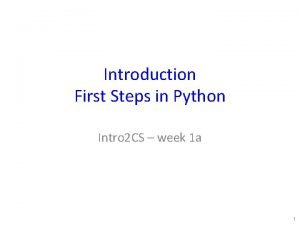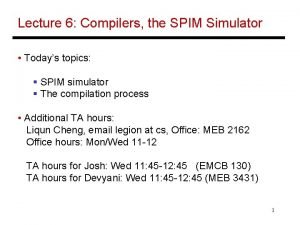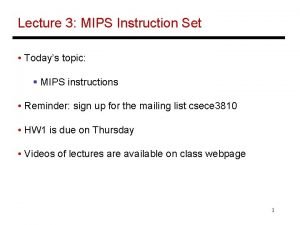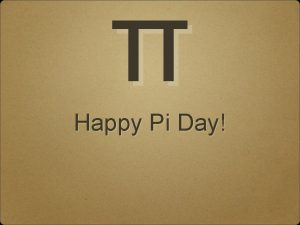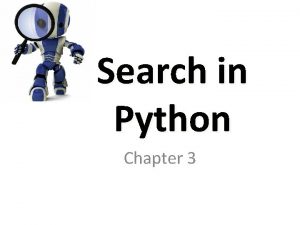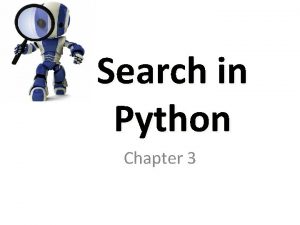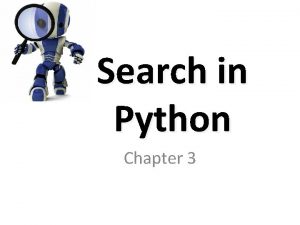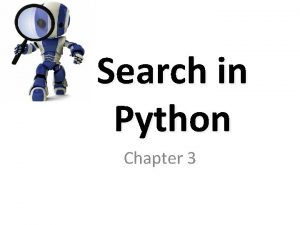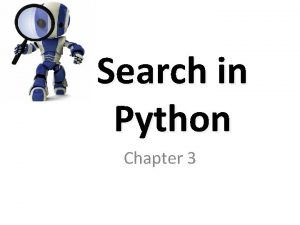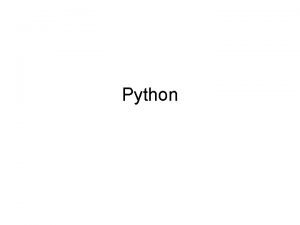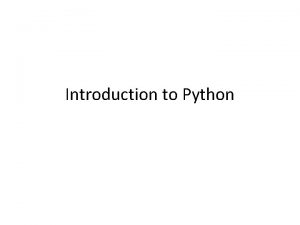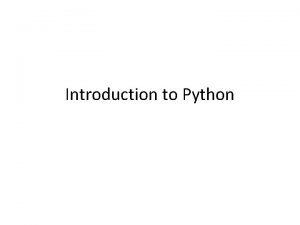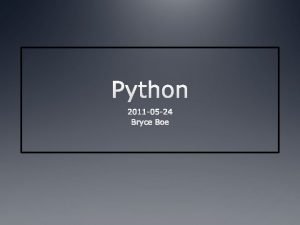Search in Python Chapter 3 Todays topics Norvigs










![Comparing Search Algorithms Results def main(): searchers = [breadth_first_tree_search, breadth_first_graph_search, depth_first_graph_search, …] problems = Comparing Search Algorithms Results def main(): searchers = [breadth_first_tree_search, breadth_first_graph_search, depth_first_graph_search, …] problems =](https://slidetodoc.com/presentation_image_h2/19feb1314b144109c8f9c6cbc70f9dc6/image-11.jpg)

- Slides: 12

Search in Python Chapter 3

Today’s topics Norvig’s Python code What it does How to use it A worked example: water jug program • What about Java? • •

Overview To use the AIMA python code for solving the two water jug problem (WJP) using search we need one problem-specific file: – wj. py: need to write this to define the problem, states, goal, successor function, etc. And three general files: – search. py: Norvig’s generic search framework, imported by wj. py – util. py and agents. py: more generic Norvig code imported by search. py

Two Water Jugs Problem • Given two water jugs, J 1 and J 2, with capacities C 1 and C 2 and initial amounts W 1 and W 2, find actions to end up with amounts W 1’ and W 2’ in the jugs • Example problem: – We have a 5 gallon and a 2 gallon jug – Initially both are full – We want to end up with exactly one gallon in J 2 and don’t care how much is in J 1

search. py • Defines a Problem class for a search problem • Provides functions to perform various kinds of search given an instance of a Problem, e. g. , breadth first, depth first, hill climbing, A*, … • Has Problem subclass Instrumented. Problem, and function, compare_searchers, for evaluation • To use for WJP: (1) decide how to represent the WJP, (2) define WJP as a subclass of Problem and (3) provide methods to (a) create a WJP instance, (b) compute successors and (c) test for a goal �

Two Water Jugs Problem Given J 1 and J 2 with capacities C 1 and C 2 and initial amounts W 1 and W 2, find actions to end up with W 1’ and W 2’ in jugs State Representation State = (x, y), where x & y are water in J 1 & J 2 • Initial state = (5, 0) • Goal state = (*, 1), where * is any amount Operator table Actions Cond. Transition Effect Empty J 1 – (x, y)→(0, y) Empty J 1 (x, y)→(x, 0) Empty J 2 – 2 to 1 x≤ 3 (x, 2)→(x+2, 0) Pour J 2 into J 1 1 to 2 x≥ 2 (x, 0)→(x-2, 2) Pour J 1 into J 2 1 to 2 part y<2 (1, y)→(0, y+1) Pour J 1 into J 2 until full

Our WJ problem class WJ(Problem): def __init__(self, capacities=(5, 2), initial=(5, 0), goal=(0, 1)): self. capacities = capacities self. initial = initial self. goal = goal def goal_test(self, state): # returns True iff state is a goal state g = self. goal return (state[0] == g[0] or g[0] == '*' ) and (state[1] == g[1] or g[1] == '*') def __repr__(self): # returns string representing the object return "WJ(%s, %s)" % (self. capacities, self. initial, self. goal)

Our WJ problem class def successor(self, (J 1, J 2)): # returns list of successors to state successors = [] (C 1, C 2) = self. capacities if J 1 > 0: successors. append((‘Dump J 1', (0, J 2))) if J 2 > 0: successors. append((‘Dump J 2', (J 1, 0))) if J 2 < C 2 and J 1 > 0: delta = min(J 1, C 2 – J 2) successors. append((‘Pour J 1 into J 2', (J 1 - delta, J 2 + delta))) if J 1 < C 1 and J 2 > 0: delta = min(J 2, C 1 – J 1) successors. append(('pour J 2 into J 1', (J 1 + delta, J 2 - delta))) return successors

Solving a WJP code> python >>> from wj import *; from search import * >>> p 1 = WJ((5, 2), ('*', 1)) >>> p 1 WJ((5, 2), ('*', 1)) >>> answer = breadth_first_graph_search(p 1) >>> answer <Node (0, 1)> >>> answer. path_cost 6 >>> path = answer. path() >>> path # Import wj. py and search. py # Create a problem instance # Used the breadth 1 st search function # Will be None if the search failed or a # a goal node in the search graph if successful # The cost to get to every node in the search graph # is maintained by the search procedure # A node’s path is the best way to get to it from # the start node, i. e. , a solution [<Node (0, 1)>, <Node (1, 0)>, <Node (1, 2)>, <Node (3, 0)>, <Node (3, 2)>, <Node (5, 0)>, <Node (5, 2)>] >>> path. reverse() >>> path [<Node (5, 2)>, <Node (5, 0)>, <Node (3, 2)>, <Node (3, 0)>, <Node (1, 2)>, <Node (1, 0)>, <Node (0, 1)>]

Comparing Search Algorithms Results • Uninformed searches: breadth_first_tree_search, breadth_first_graph_search, depth_first_graph_ search, iterative_deepening_search, depth_limited_ search • All but depth_limited_search are sound (solutions found are correct) • Not all are complete (always find a solution if one exists) • Not all are optimal (find best possible solution) • Not all are efficient • AIMA code has a comparison function
![Comparing Search Algorithms Results def main searchers breadthfirsttreesearch breadthfirstgraphsearch depthfirstgraphsearch problems Comparing Search Algorithms Results def main(): searchers = [breadth_first_tree_search, breadth_first_graph_search, depth_first_graph_search, …] problems =](https://slidetodoc.com/presentation_image_h2/19feb1314b144109c8f9c6cbc70f9dc6/image-11.jpg)
Comparing Search Algorithms Results def main(): searchers = [breadth_first_tree_search, breadth_first_graph_search, depth_first_graph_search, …] problems = [WJ((5, 2), (5, 0), (0, 1)), WJ((5, 2), (5, 0), (2, 0))] for p in problems: for s in searchers: print ‘Solution to’, p, ‘found by’, s. __name__ path = s(p). path() # call search function with problem path. reverse() print path, ‘n’ # print solution path print ‘SUMMARY: successors/goal tests/states generated/solution’ # Now call the comparison function to show data about the performance of the dearches compare_searchers(problems=problems, header=['SEARCHER', 'GOAL: (0, 1)', 'GOAL: (2, 0)'], searchers=[breadth_first_tree_search, breadth_first_graph_search, depth_first_graph_search, …]) # if called from the command line, call main() if __name__ == "__main__”: main()

The Output code> python wj. py Solution to WJ((5, 2), (5, 0), (0, 1)) found by breadth_first_tree_search [<Node (5, 0)>, <Node (3, 2)>, <Node (3, 0)>, <Node (1, 2)>, … , <Node (0, 1)>] … Solution to WJ((5, 2), (5, 0), (2, 0)) found by depth_limited_search [<Node (5, 0)>, <Node (3, 2)>, <Node (0, 2)>, <Node (2, 0)>] SUMMARY: successors/goal tests/states generated/solution SEARCHER GOAL: (0, 1) GOAL: (2, 0) breadth_first_tree_search < 25/ 26/ 37/(0, > < 7/ 8/ 11/(2, > breadth_first_graph_search < 8/ 17/ 16/(0, > < 5/ 8/ 9/(2, > depth_first_graph_search < 5/ 8/ 12/(0, > < 8/ 13/ 16/(2, > iterative_deepening_search < 35/ 61/ 57/(0, > < 8/ 16/ 14/(2, > depth_limited_search < 194/ 199/ 200/(0, > < 5/ 6/ 7/(2, > code>
